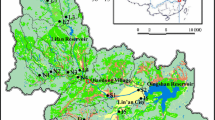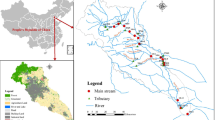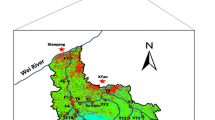Abstract
The composition of dissolved organic matter (DOM) is an important determinant for its biogeochemical role in the aquatic environments. Therefore, it is crucial to determine the effects of changing land use on the DOM composition in the river watershed. Water samples were collected from the outlets of 15 sub-watersheds in the subtropical Jiulong River (southeast China) for fluorescence measurements and parallel factor analysis. Two humic-like (C1 and C2) and one protein-like (C3) fluorescent components were identified. Overall, DOM in the Jiulong River watershed was dominated by humic-like materials, probably due to the fact that 69% of the watershed is covered with forest. The 15 sub-watersheds were grouped into four clusters based on the proportion of each fluorescent component in the total fluorescence, suggesting that the DOM composition could be very different among sub-watersheds. There was a strong negative correlation between C2 and C3%. C1% correlated with the water body fraction, likely associated with the aquatic production of C1. C3% correlated positively with the residential area fraction, likely indicating the influence of anthropogenic activities. These results are useful for assessing the effects of land use/land cover changes on the composition and hence biogeochemical roles of DOM in aquatic environments.





Similar content being viewed by others
References
Amon RMW, Benner R (1996) Bacterial utilization of different size classes of dissolved organic matter. Limnol Oceanogr 41:41–51
Arrigo KR, Brown CW (1996) Impact of chromophoric dissolved organic matter on UV inhibition of primary productivity in the sea. Mar Ecol-Prog Ser 140:207–216
Baker A (2001) Fluorescence excitation-emission matrix characterization of some sewage-impacted rivers. Environ Sci Technol 35:948–953
Balcarczyk K, Jones J, Jaffé R et al (2009) Stream dissolved organic matter bioavailability and composition in watersheds underlain with discontinuous permafrost. Biogeochemistry 94:255–270
Bushaw KL, Zepp RG, Tarr MA et al (1996) Photochemical release of biologically available nitrogen from aquatic dissolved organic matter. Nature 381:404–407
Chen NW, Hong HS, Zhang LP et al (2008) Nitrogen sources and exports in an agricultural watershed in Southeast China. Biogeochemistry 87:169–179
Coble PG (1996) Characterization of marine and terrestrial DOM in seawater using excitation-emission matrix spectroscopy. Mar Chem 51:325–346
Cory RM, McKnight DM (2005) Fluorescence spectroscopy reveals ubiquitous presence of oxidized and reduced quinones in dissolved organic matter. Environ Sci Technol 39:8142–8149
Fellman JB, Hood E, D’Amore DV et al (2009) Seasonal changes in the chemical quality and biodegradability of dissolved organic matter exported from soils to streams in coastal temperate rainforest watersheds. Biogeochemistry 95:277–293
Guo WD, Stedmon CA, Han YC et al (2007) The conservative and non-conservative behavior of chromophoric dissolved organic matter in Chinese estuarine waters. Mar Chem 107:357–366
Guo WD, Xu J, Wang JP et al (2010) Characterization of dissolved organic matter in urban sewage using excitation emission matrix fluorescence spectroscopy and parallel factor analysis. J Environ Sci-China 22:1728–1734
Guo WD, Yang LY, Hong HS et al (2011) Assessing the dynamics of chromophoric dissolved organic matter in a subtropical estuary using parallel factor analysis. Mar Chem 124(1–4):125–133
Hedges JI, Keil RG, Benner R (1997) What happens to terrestrial organic matter in the ocean? Org Geochem 27:195–212
Hong HS, Yang LY, Guo WD et al (2011) Characterization of dissolved organic matter under contrasting hydrologic regimes in a subtropical watershed using PARAFAC model. Biogeochemistry. doi:10.1007/s10533-011-9617-8
Hood E, Fellman J, Spencer RGM et al (2009) Glaciers as a source of ancient and labile organic matter to the marine environment. Nature 462:1044–1047
Huang W, Chen RF (2009) Sources and transformations of chromophoric dissolved organic matter in the Neponset River Watershed. J Geophys Res 114:G00F05. doi:10.1029/2009JG000976
Huang J, Pontius RG, Li Q et al (2010) Acceleration of land transitions among agriculture, natural and built from 1986 to 2007 in a Subtropical Coastal Watershed, China. Poster at the Open Science Meeting of the Global Land Project, Tempe, Arizona, 17–19 Oct 2010
Huang J, Li Q, Hong H et al (2011) Preliminary study on linking land use & landscape pattern and water quality in the Jiulong River Watershed. Environmental Science 32:64–72
Hudson N, Baker A, Reynolds D (2007) Fluorescence analysis of dissolved organic matter in natural, waste and polluted waters—a review. River Res Appl 23:631–649
Hunt AP, Parry JD, Hamilton-Taylor J (2000) Further evidence of elemental composition as an indicator of the bioavailability of humic substances to bacteria. Limnol Oceanogr 45:237–241
Jennerjahn TC, Nasir B, Pohlenga I (2009) Spatio-temporal variation of dissolved inorganic nutrients related to hydrodynamics and land use in the mangrove-fringed Segara Anakan Lagoon, Java, Indonesia. Reg Environ Change 9:259–274
Kowalczuk P, Durako MJ, Young H et al (2009) Characterization of dissolved organic matter fluorescence in the South Atlantic Bight with use of PARAFAC model: interannual variability. Mar Chem 113:182–196
Lawaetz AJ, Stedmon CA (2009) Fluorescence intensity calibration using the Raman scatter peak of water. Appl Spectrosc 63:936–940
Loh AN, Bauer JE, Druffel ERM (2004) Variable ageing and storage of dissolved organic components in the open ocean. Nature 430:877–881
Moran MA, Zepp RG (1997) Role of photoreactions in the formation of biologically labile compounds from dissolved organic matter. Limnol Oceanogr 42:1307–1316
Nixon SW, Fulweiler RW (2011) Ecological footprints and shadows in an urban estuary, Narragansett Bay, RI (USA). Reg Environ Change. doi:10.1007/s10113-011-0221-1
Romera-Castillo C, Sarmento H, Álvarez-Salgado XA et al (2010) Production of chromophoric dissolved organic matter by marine phytoplankton. Limnol Oceanogr 55:446–454
Shank GC, Zepp RG, Vähätalo A et al (2010) Photobleaching kinetics of chromophoric dissolved organic matter derived from mangrove leaf litter and floating Sargassum colonies. Mar Chem 119:162–171
Spencer RGM, Stubbins A, Hernes PJ et al (2009) Photochemical degradation of dissolved organic matter and dissolved lignin phenols from the Congo River. J Geophys Res 114:G03010. doi:10.1029/2009JG000968
Stedmon CA, Bro R (2008) Characterizing dissolved organic matter fluorescence with parallel factor analysis: a tutorial. Limnol Oceanogr-Meth 6:572–579
Stedmon CA, Markager S (2005a) Resolving the variability in dissolved organic matter fluorescence in a temperate estuary and its catchment using PARAFAC analysis. Limnol Oceanogr 50:686–697
Stedmon CA, Markager S (2005b) Tracing the production and degradation of autochthonous fractions of dissolved organic matter by fluorescence analysis. Limnol Oceanogr 50:1415–1426
Stedmon CA, Markager S, Bro R (2003) Tracing dissolved organic matter in aquatic environments using a new approach to fluorescence spectroscopy. Mar Chem 82:239–254
White EM, Kieber DJ, Sherrard J et al (2010) Carbon dioxide and carbon monoxide photoproduction quantum yields in the Delaware Estuary. Mar Chem 118:11–21
Williams CJ, Yamashita Y, Wilson HF et al (2010) Unraveling the role of land use and microbial activity in shaping dissolved organic matter characteristics in stream ecosystems. Limnol Oceanogr 55:1159–1171
Wilson HF, Xenopoulos MA (2009) Effects of agricultural land use on the composition of fluvial dissolved organic matter. Nature Geosci 2:37–41
Wong AWM, Wong MH (2004) Recent socio-economic changes in relation to environmental quality of the Pearl River delta. Reg Environ Change 4:28–38
Yamashita Y, Maie N, Briceno H et al (2010) Optical characterization of dissolved organic matter in tropical rivers of the Guayana Shield, Venezuela. J Geophys Res 115, G00F10. doi:10.1029/2009JG000987
Acknowledgments
This work was supported by the funds from National Natural Science Foundation of China (No. 40810069004 and 40776041), National High Technology Research and Development Program of China (No. 2007AA091704) and the Program for New Century Excellent Talents (NCET) for Weidong Guo. We thank Zengrong Zhou, Mingchao Qu and Wenfang Lu for their assistances in sample collection and field water quality measurements and Jing Xu for her assistance in PARAFAC modeling. Dr. Kunming Xu is thanked for helpful discussions on the statistic problems. Great thanks to Dr. Stephen V. Smith and one anonymous reviewer for their comments that greatly improved the quality of the manuscript.
Author information
Authors and Affiliations
Corresponding author
Rights and permissions
About this article
Cite this article
Yang, L., Hong, H., Guo, W. et al. Effects of changing land use on dissolved organic matter in a subtropical river watershed, southeast China. Reg Environ Change 12, 145–151 (2012). https://doi.org/10.1007/s10113-011-0250-9
Received:
Accepted:
Published:
Issue Date:
DOI: https://doi.org/10.1007/s10113-011-0250-9




